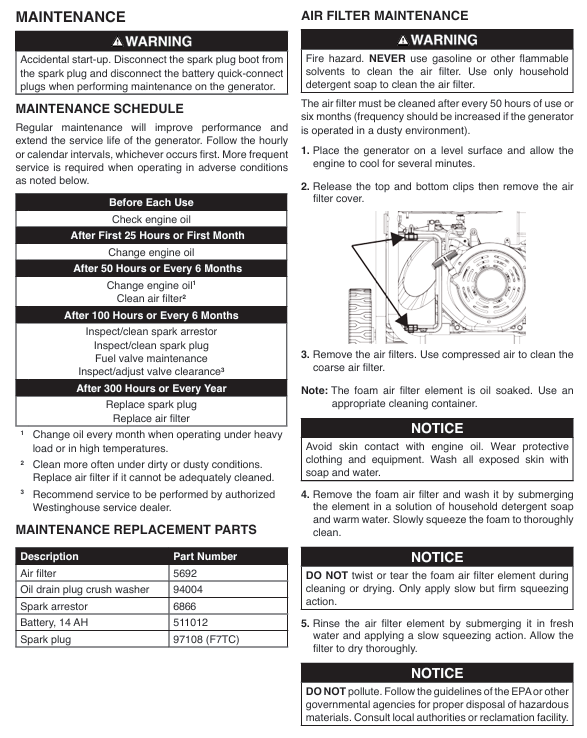Westinghouse WGen9500c portable generator
Power specification: 120/240V single-phase AC, frequency 60Hz, speed 3600rpm, voltage stability range 230-250V, frequency stability range 58-62Hz, suitable for most household and industrial equipment
No output voltage: 1. Main circuit breaker tripped; 2. GFCI socket not reset; 3. Loose wiring or poor plug contact; 4. Internal winding failure of the generator; 5. Load short circuit triggering protection 1. Check if the control panel circuit breaker has tripped; 2. Press the "RESET" button on the GFCI socket; 3. Check if the output socket and wiring are loose; 4. Disconnect all loads, restart and test; 5. Check if the connected device is short circuited. 1. Reset the circuit breaker after checking for overload; 2. Reset the GFCI socket, if it still does not work, replace the socket; 3. Tighten the wiring and plugs; 4. If there is still no output, contact after-sales maintenance; 5. Replace faulty equipment
Remote start failure (normal electric start) 1. The remote control battery is dead; 2. Remote control not paired; 3. Remote control receiving module malfunction: 1. Replace the remote control CR2016 battery; 2. Re pair according to the manual (long press the "MODE" button on the control panel for 3 seconds, then press the "START" button on the remote control); 3. Check if the wiring of the receiving module is loose. 1. Replace the remote control battery; 2. Re pair; 3. If the wiring is still ineffective, replace the receiving module
Abnormal noise during operation (knocking/whistling sound): 1. Loose spark plug; 2. Wear and tear of internal engine components; 3. Malfunction of the cooling fan; 4. Loose components (such as footrests and rollers); 5. Spark arrester blockage 1. Check if the spark plug is tightened; 2. Listen to the source of abnormal noise (cylinder, fan, body); 3. Check if the cooling fan is rotating normally; 4. Check if the body screws and tripod are loose; 5. Clean the spark arrester. 1. Tighten the spark plug; 2. Immediately stop the machine and contact after-sales maintenance; 3. Repair or replace the cooling fan; 4. Tighten loose parts; 5. Clean the spark arrester and replace it if it is damaged
Rapid fuel consumption: 1. Excessive load (long-term full load operation); 2. Malfunction of carburetor (poor fuel atomization); 3. Improper engine valve clearance; 4. Fuel leakage: 1. Check if the load has been close to 9500W for a long time; 2. Check if the carburetor is blocked or improperly adjusted; 3. Check the valve clearance; 4. Check for leaks in the fuel tank and oil pipes. 1. Reduce the load to avoid long-term full load; 2. Clean or debug the carburetor (professional operation); 3. Adjust the valve clearance by the technician; 4. Repair the leaking area
CO alarm light on and shutdown: 1. Poor environmental ventilation; 2. CO sensor malfunction; 3. Blockage of exhaust pipe 1. Check if the usage environment is sealed; After transferring to the ventilation area and restarting, if the alarm still sounds, the sensor is faulty; 3. Check if the exhaust pipe is blocked. 1. Move it to an outdoor ventilated area for use; 2. Contact after-sales service to replace the CO sensor; 3. Clean the exhaust pipe and remove blockages
The socket has no power (other sockets are normal). 1. The GFCI protection of this socket has tripped; 2. Loose internal wiring of the socket; 3. The socket is damaged. 1. Press the "RESET" button on the socket; 2. Turn off the generator and check the socket wiring; 3. Replace the known normal device for testing. 1. Reset GFCI, if it still does not work, check for a short circuit in the device; 2. Tighten the wiring; 3. Replace the socket (professional operation)

- EMERSON
- Honeywell
- CTI
- Rolls-Royce
- General Electric
- Woodward
- Yaskawa
- xYCOM
- Motorola
- Siemens
- Rockwell
- ABB
- B&R
- HIMA
- Construction site
- electricity
- Automobile market
- PLC
- DCS
- Motor drivers
- VSD
- Implications
- cement
- CO2
- CEM
- methane
- Artificial intelligence
- Titanic
- Solar energy
- Hydrogen fuel cell
- Hydrogen and fuel cells
- Hydrogen and oxygen fuel cells
- tyre
- Chemical fiber
- dynamo
- corpuscle
- Pulp and paper
- printing
- fossil
- FANUC
- Food and beverage
- Life science
- Sewage treatment
- Personal care
- electricity
- boats
- infrastructure
- Automobile industry
- metallurgy
- Nuclear power generation
- Geothermal power generation
- Water and wastewater
- Infrastructure construction
- Mine hazard
- steel
- papermaking
- Natural gas industry
- Infrastructure construction
- Power and energy
- Rubber and plastic
- Renewable energy
- pharmacy
- mining
- Plastic industry
- Schneider
- Kongsberg
- NI
- Wind energy
- International petroleum
- International new energy network
- gas
- WATLOW
- ProSoft
- SEW
- wind
- ADVANCED
- Reliance
- YOKOGAWA
- TRICONEX
- FOXBORO
- METSO
- MAN
- Advantest
- ADVANCED
- ALSTOM
- Control Wave
- AB
- AMAT
- STUDER
- KONGSBERG
- MOTOROLA
- DANAHER MOTION
- Bently
- Galil
- EATON
- MOLEX
- Triconex
- DEIF
- B&W
- ZYGO
- Aerotech
- DANFOSS
- KOLLMORGEN
- Beijer
- Endress+Hauser
- MOOG
- KB
- Moxa
- Rexroth
- YAMAHA
- Johnson
- Westinghouse


Email:wang@kongjiangauto.com


































































































































